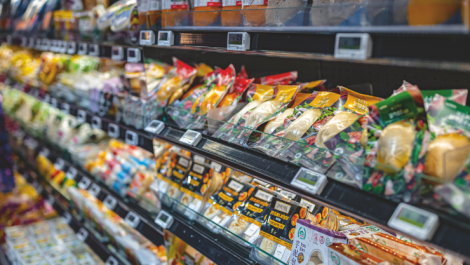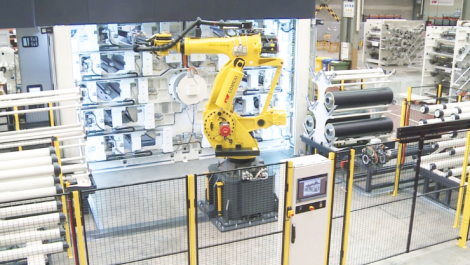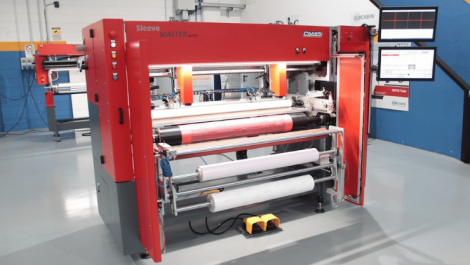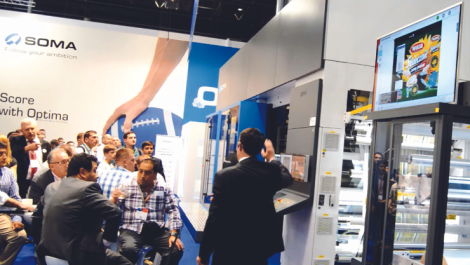As packaging applications become more demanding, so adhesive technology develops to ensure it performs to the required standard. Legislation and demands for sustainability are also major drivers, and the market is growing rapidly.
Inks, coating and adhesives all have to respond to the market needs for innovation and new types of packaging that meet the legislative requirements, high performance demands and low environmental impact.
Industry researcher marketsandmarkets.com reports that the global packaging adhesives market has witnessed a good growth in the past few years and this is estimated to continue. Properties such as tackiness, handling strength, curing conditions, peel stress, withstanding temperature range and performance under various conditions will be the key influencing factors.
Don’t tamper
In terms of high performance, Herma has recently introduced HERMAsuperPerm 63S for applications that require extremely high final adhesion, such as tamper-evident closure, long-term labelling and seal labels.
Introduced at Labelexpo, the adhesive enables conventional labels to be used to implement tamper-evident solutions as required by the EU’s pharmaceutical directive coming into force next year. Sealing labels equipped with this adhesive cannot be removed without destruction of the label or the packaging surface. The final adhesion is so high that sealing labels cannot be removed from lacquered pharmaceutical packaging nor many other polar and non-polar surfaces, such as paper, cardboard, or plastics and steel.
Suitable for universal use, HERMAsuperPerm 63S is resistant to water, hot air and various solvents. It is a dispersion adhesive, which means that the adhesive materials can be easily processed in spite of relatively thick adhesive coating. It can also be employed in other applications where authenticity, safety and inspection seals are required, such as in the automotive, electronics and food sectors.
‘Labels on pharmaceutical packaging are, as a matter of principle, accepted in the market. Moreover, they do not change the established appearance of existing packages,’ explained Ulli Nägele, Herma’s head of development. ‘Folding boxes and folding box machines that have already been validated can continue to be used.’ He continued, ‘The main reason against using conventional, economic labels for reliable tamper-proofing is the fact that they are removable.’
Tough bonding
UPM Raflatac has introduced a new RX series of adhesives to meet the need for challenging applications and sustainability, such durable goods, electronics and automotive labelling where solvent adhesives were previously the only alternative.
A solvent-free adhesive, RX 15 bonds to polar substrates like steel, glass, polycarbonate, nylon and ABS plastic. Ultra-high tack is matched by very high cohesion that provides tested resistance to chemicals and UV light, and prevents shearing under high temperatures. In label conversion, this means that the adhesive is highly resistant to bleeding and stringing.
The high cohesion of RX 15 derives from a high proportion of chemical cross-links locking together the molecules in the adhesive. The cross-linking reaction is activated by the introduction of a catalyst after the adhesive has been coated during label stock manufacture.
The new adhesive promises to significantly reduce the environmental impact of labels by lowering energy consumption, water usage and carbon emissions. ‘When viable alternatives present themselves, history shows that solvent adhesives are quickly abandoned. The solvent-free RX 15 closes one chapter and opens another in the continual evolution of self-adhesive labelling,’ said Martti Vähälä, labelling solutions manager.
Sustainable labelling
The removal of self-adhesive labels from glass bottles can be a challenge during the recycling process, affecting both the quality and availability of recycled material. To provide a solution to this problem, Avery Dennison has introduced a proprietary labelling technology that allows clear separation of self-adhesive labels from glass.
‘Avery Dennison recognises that post-consumer recycling is one of the key elements of sustainable packaging,’ commented Vladimir Tyulpin, business development and product manager at the company’s Materials Group Europe. ‘Brand owners are striving to make their packaging more sustainable, and to contribute to a circular economy. Such initiatives are important and they can also help businesses to differentiate from the competition, with a positive brand value perception.’
Avery Dennison Glass Recycling materials uses an adhesive that has been engineered to facilitate easy label removal from the glass bottle surface. This adhesive ‘switches off’ during the glass bottle recycling process, to facilitate clean separation of the label from the glass. Transitioning to the new labelling material does not require investment in new equipment or changes to existing processes.
The company said that the new technology can enable the reduction of glass going to landfill to 1.5 kg per tonne (versus 40 kg), and limit label fragment contamination to 2% of label material (versus up to 74%).
Easy wash off
Also on the sustainability trail is HB Fuller, which has launched a new water-based pressure sensitive adhesive, aimed at helping beverage producers remove PSA labels during the label wash-off process of returnable bottles.
Formulated using proprietary polymer technology, Fulltak SE 8301 connects coating, drying and conversion performance to offer optimal labelling performance and clean label removal.
Under typical conditions, the adhesive promises to deliver two hours’ ice water resistance, thus maintaining brand integrity during use. Returned bottles are easily processed through the wash-off cycle as labels coated with this new adhesive can be cleanly removed during a warm, caustic wash-off process, and also remains coated on the label, minimising contamination of the wash water.
No bubbles
Japanese Lintec has developed an easy-to-apply, blister-free label stock with an adhesive design that provides a release mechanism for volatile gases. Previously, the technique used to achieve an adhesive with blister-free ability involved transcripting the concave-convex shape to the adhesive surface using embossed release liner upon coating.
This label stock developed with a new manufacturing process differs from the conventional blister-free label stock in the way of forming a concave-convex shape on the surface of the adhesive, with their shape self-formed to provide bubble-free ability.
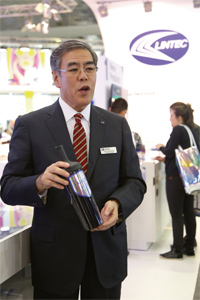
Lintec introduced bubble free labelstock at Labelexpo.
Due to the random orientation of the concave-convex morphology of the adhesive surface, there are fewer problems with the punching process, and the adhesive surface doesn’t select the release liner surface so that back-slitting is possible. Another feature of this new product is that it has superior retention of concave-convex shape, and therefore shows little deterioration in performance even when repeatedly placed in a high-temperature environment.
Adapting to demand
Frimpeks specialises in the production of a variety of products for the print and packaging industries, including adhesives both off the shelf and bespoke.
The company reports that recent trends in the use of ticket and tag products have seen the need for manufacturers to develop innovative ways of applying spot and flood adhesive, with the correct tack or peel attributes. Product variants or uses illustrated by the adhesives technical team at Frimpeks include tag, luggage, ticket and postal applications using a variety of substrates that are either rigid, waterproof, wipeable, printed two sides and/or tear resistant. The coatings also have to be flexible in order to perform in a variety of systems, such as water-based, hot melt, solvent and PU.
Managing director Emre Sayer commented, ‘The market place is getting bigger and more diverse. As we enter new countries and continents, we see a variation in the use of label stock material and of course the adhesive preferences. As a large player we are seeing product enhancements when adapting adhesive to different climates, humidity, applications, manufacturing systems and in the case of ticketing and tag labels some subtle system infrastructure differences.
The company offers online product selectors for converters to research the specifications and build the layers themselves. Mr Sayer continued, ‘We are constantly tweaking our products and therefore specifications. So the easy access digital platforms provide means we can offer choice quickly and efficiently in what is a time poor and low margin industry. That said we still develop ‘specials’ and bespoke adhesives to work on unique applications.
New range for flexo
Ultrachem is an independent supplier and manufacturer of inks, coatings and pressroom chemicals. ‘We are building upon our recent successful partnership with Actega Colorchemie with its high quality water-based inks, by developing our own comprehensive fully integrated water-based and UV coatings and adhesives ranges for the UK flexo market sector,’ said Geoff Woodacre, business development manager for the water-based flexo division.
The new range is manufactured in the UK at Ultrachem’s dedicated coating and adhesive facility in Bristol, and the comprehensive portfolio covers water-based and UV coatings, including gloss, matt, satin, soft touch, low migration and the ‘Safe To Touch’ antibacterial coating.
This is supported by a full range of water-based and fastbond UV curing adhesives, suitable for various applications across a wide range of industry sectors, including flexible packaging, pre- and post-print corrugated, gift wrap papers, sacks and bags, tissue and envelope, and labels. Fastbond is free of toxic chemicals, HDDA and benzophenone, and has been designed to be used on food packaging. It also forms a barrier for chemicals, moisture and gases and is ideal for overcoming adhesion issues with films and boards.
The Bristol facility also offers bespoke products for customer specific applications.


